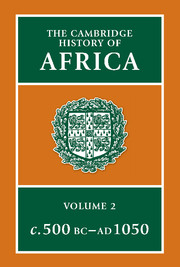Crossref Citations
This Book has been
cited by the following publications. This list is generated based on data provided by Crossref.
Kamugisha, Aaron
2003.
Finally in Africa? Egypt, from Diop to Celenko.
Race & Class,
Vol. 45,
Issue. 1,
p.
31.
Brett, Michael
2004.
The New Cambridge Medieval History.
p.
675.
Humphreys, Stephen
2004.
The New Cambridge Medieval History.
p.
721.
Gilarowski, Jerzy
2006.
Natural and Cultural Landscapes of Equatorial Africa.
Miscellanea Geographica,
Vol. 12,
Issue. 1,
p.
155.
Awadelkarim, Khalid Dafaallah
Aceto, Gitana
Veschi, Serena
Elhaj, Ahmed
Morgano, Annalisa
Mohamedani, Ahmed Abdalla
Eltayeb, Elgaylani Abdalla
Abuidris, Dafaallah
Di Gioacchino, Mario
Battista, Pasquale
Verginelli, Fabio
Cama, Alessandro
Elwali, Nasr Eldin
and
Mariani-Costantini, Renato
2007.
BRCA1 and BRCA2 status in a Central Sudanese series of breast cancer patients: interactions with genetic, ethnic and reproductive factors.
Breast Cancer Research and Treatment,
Vol. 102,
Issue. 2,
p.
189.
Maurel, Chloé
2014.
L’histoire générale de l’Afrique de l’Unesco.
Cahiers d'études africaines,
p.
715.
Parmeggiani, Giovanni
2020.
Notes on the Tradition of the Peace of Callias.
Erga-Logoi. Rivista di storia, letteratura, diritto e culture dell'antichità,
Vol. 8,
Issue. 2,
Ahaligah, Aidan Kwame
2020.
Early African Christianity–A Thematic Analysis.
E-Journal of Religious and Theological Studies,
p.
264.
Paglione, M. Licia
and
Luppi, Marco
2024.
Charismatic Embeddedness: A Cultural Starting Mechanism Generating Relational Goods in an Interreligious Field. An Analysis from Algeria.
Religions,
Vol. 15,
Issue. 1,
p.
58.



